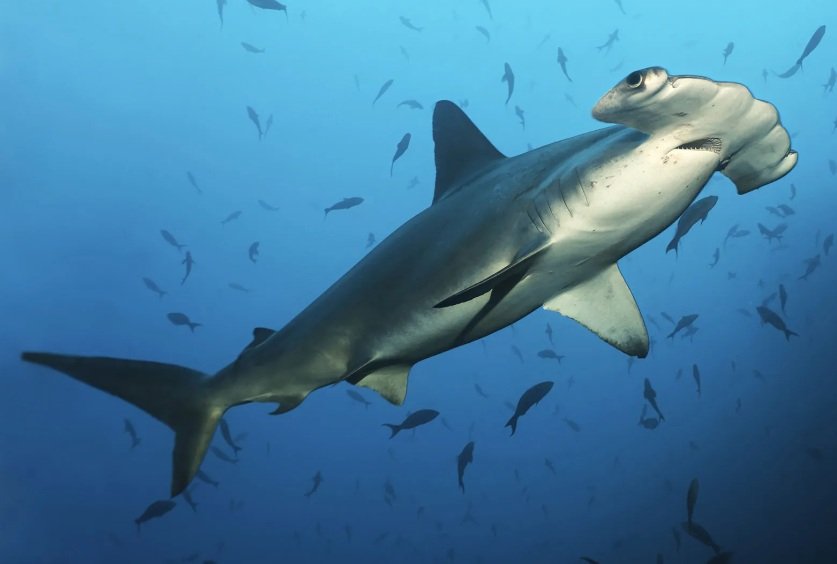
Quick Top 10 Facts about Smooth Hammerhead Shark
| SCIENTIFIC NAME | Sphyrna zygaena |
| CLASSIFICATION | KINGDOM: Animalia PHYLUM: Chordata CLASS: Chondrichthyes ORDER: Carcharhiniformes FAMILY: Sphyrnidae GENUS: Sphyrna SPECIES: S. zygaena |
| SIZE | Length: 10–14 feet (3–4.3 meters) Weight: Up to 500 pounds (227 kg) |
| HABITAT | Coastal temperate and tropical waters, usually near continental shelves |
| DIET | Carnivorous; feeds primarily on fish, squid, and rays |
| SPECIES | Smooth Hammerhead Shark, a species known for its unique, flattened head |
| COUNTRY | Found in oceans around the world, particularly in temperate coastal regions |
| GESTATION PERIOD | 10–12 months |
| LIFE SPAN | 20–30 years |
| CONSERVATION STATUS | Vulnerable; populations are threatened by overfishing and habitat degradation |
Amazing Facts About Smooth Hammerhead Sharks
1. They have a unique head shape
The most striking feature of the Smooth Hammerhead Shark is its broad, flattened head, which improves its ability to detect prey.
2. They are excellent hunters
The wide head of the Smooth Hammerhead allows them to scan a large area of the ocean floor for prey, making them highly efficient predators.
3. They have good vision
The shape of their head gives them a wide field of vision, allowing them to see both above and below them simultaneously.
4. They are social sharks
Smooth Hammerhead Sharks are often found in schools, particularly during the summer months, although they can also be solitary.
5. They use electroreception to locate prey
Smooth Hammerheads use specialized organs called ampullae of Lorenzini to detect the electrical signals emitted by their prey, such as fish and rays.
6. They are migratory
Smooth Hammerhead Sharks are known to migrate over long distances, often in search of food or breeding grounds.
7. They have a varied diet
Their diet primarily consists of fish, squid, and rays, but they may also feed on crustaceans and other small marine creatures.
8. They are not considered a threat to humans
Although large and powerful, Smooth Hammerhead Sharks are generally not considered dangerous to humans, with very few attacks recorded.
9. They play an important role in marine ecosystems
As top predators, Smooth Hammerheads help regulate the populations of smaller fish and marine life, contributing to the health of marine ecosystems.
10. They are threatened by human activities
Overfishing, habitat loss, and the shark fin trade have led to a decline in Smooth Hammerhead Shark populations, and they are listed as vulnerable by conservation organizations.
Fascinating facts about Smooth Hammerhead Shark
Smooth hammerhead sharks, scientifically known as Sphyrna zygaena, are fascinating creatures that inhabit temperate and tropical waters worldwide. These sharks are characterized by their unique hammer-shaped heads, which are thought to enhance their sensory abilities, particularly in detecting prey. Smooth hammerheads are known to travel in schools and are apex predators, feeding on a variety of prey, including fish, squid, and crustaceans. Despite being listed as “vulnerable” by the International Union for Conservation of Nature (IUCN), these sharks continue to face threats from overfishing and habitat degradation. Understanding the biology and behavior of smooth hammerhead sharks is crucial for their conservation and the overall health of marine ecosystems.
Introduction to Smooth Hammerhead Sharks
Sphyrna zygaena, the official name for the Smooth Hammerhead Shark, is an amazing animal that lives in waters across the globe. This shark species is distinguished from its relatives by its unique hammer-shaped head. Having a maximum length of 14 feet and a mass of over 500 pounds, these sharks are quite remarkable.
Social Behavior and grouping of Smooth Hammerhead Sharks
The smooth hammerhead shark’s social behavior is one of its most fascinating features. These sharks have the ability to form enormous groups, sometimes numbering in the hundreds, in contrast to many other shark species. These groups allow them to travel the vast ocean together and feel secure. It is thought that their social behavior aids in their ability to hunt, mate, and even defend themselves against any predators.
Feeding Habits and Adaptations of Smooth Hammerhead Sharks
Smooth Hammerhead Sharks primarily eat fish, squid, and crustaceans. They are skilled hunters who make effective use of their distinctive head shape. By extending their range of view, the hammer-like feature called a cephalofoil helps them identify prey more effectively. Thanks to this adaptability, they can also find and catch anything that is lurking in the sand or coral reefs. They can quickly capture and devour their food thanks to their strong jaws and pointed teeth, which helps ensure their survival in the vast ocean habitat.

Exploring the Smooth Hammerhead Shark: Key Insights
With its unusual head form and amazing skills, the smooth hammerhead shark is an amazing animal. There is a lot to understand and value about this species, from its physical traits to its eating preferences and reproductive cycle. It is vital to save and maintain these amazing animals’ habitats so that future generations may appreciate and learn about them as we work to conserve our seas.
Physical Characteristics of Smooth Hammerhead Sharks
The distinctive head form of the smooth hammerhead shark—which is flattened and extended on all sides—makes it easy to identify. Because of this special characteristic, the shark has improved sensory perception, allowing it to identify prey more accurately. An adult smooth hammerhead shark’s length ranges from 10 to 14 feet on average, with females being bigger than males. Their dorsal side is colored grayish-brown, which aids in their ability to blend in with their environment.
Habitat and Distribution of Smooth Hammerhead Sharks
Smooth hammerhead sharks are found in both offshore and coastal areas, with a preference for warm, temperate climates. It is known that they live in tropical and subtropical seas worldwide, which include the Pacific, Indian, and Atlantic oceans. Due to their strong migratory nature, these sharks often traverse great distances in quest of food and favorable mating habitats.
Diet and Feeding Behavior of Smooth Hammerhead Sharks
The majority of smooth hammerhead sharks’ diet consists of carnivorous plants. They consume a wide range of foods, such as crustaceans, fish, squid, and octopuses. They can see a greater area of the environment because of the unusual shape of their heads, which makes it easier for them to find and catch prey. Because of their reputation as opportunistic predators, these sharks often feed on smaller fish and invertebrates. The capacity of the smooth hammerhead shark to consume stingrays is an intriguing eating habit. To keep the stingray from fleeing, they hold it down with their hammer-shaped heads. Once its victim is paralyzed, the shark may eat it.
Reproduction and Life Cycle of Smooth Hammerhead Sharks
Smooth hammerhead sharks are viviparous, giving birth to young. Males vigorously chase females throughout the summer months, which is when mating season usually occurs. The female shark will carry the resulting embryos in her womb for around 9 to 10 months after mating. After birth, the puppies are on their own and have to fend for themselves. A litter of twenty to forty pups is born to a female smooth hammerhead shark at a time. Newborns usually measure between two and three feet in length, and they develop quickly in the first few years of life.

Conservation Status of Smooth Hammerhead Sharks
The smooth hammerhead shark’s population is declining due to a number of issues that also affect many other shark species. The main causes of its declining population are overfishing, habitat destruction, and unintentional bycatch. The smooth hammerhead shark is the subject of conservation and protection efforts. International agreements, such as the Convention on International Trade in Endangered Species (CITES), restrict trade in this species. Regulations governing fishing and marine protected areas have also been put in place to preserve these ecosystems and lessen the effects of human activity.
FAQ (Frequently Asked Questions) about Smooth Hammerhead Shark
Q: What is a Smooth Hammerhead Shark?
Ans: The Smooth Hammerhead Shark (Sphyrna zygaena) is a species of hammerhead shark known for its distinctive T-shaped head. This species is found in warm, coastal waters around the world and is recognized for its unique cranial shape, which helps with better navigation, hunting, and sensory perception. Unlike other hammerhead species, the smooth hammerhead has a less pronounced, smooth curve to its head.
Q: Where does the Smooth Hammerhead Shark live?
Ans: The Smooth Hammerhead Shark inhabits warm temperate and tropical coastal waters, typically in the continental shelf regions. They are found in both the Atlantic and Pacific Oceans, including areas such as the Gulf of Mexico, the coastlines of Africa, South America, and parts of Southeast Asia. They are often found in deeper waters but can also be spotted in shallow coastal environments.
Q: What does the Smooth Hammerhead Shark eat?
Ans: Smooth Hammerhead Sharks are carnivorous and have a diet that includes fish, squid, and crustaceans. They are known to hunt in groups and often target schools of smaller fish, using their wide heads to improve their ability to detect prey through electroreception and other sensory abilities. They are opportunistic feeders and can adjust their hunting strategies depending on the availability of food.
Q: How big does a Smooth Hammerhead Shark get?
Ans: Smooth Hammerhead Sharks are large sharks that can grow up to 10-13 feet (3 to 4 meters) in length. Females tend to grow larger than males. Despite their size, these sharks are typically not as aggressive as some other species, and their large size allows them to dominate their environment when hunting or defending themselves.
Q: Are Smooth Hammerhead Sharks dangerous?
Ans: Smooth Hammerhead Sharks are not generally considered dangerous to humans. They are relatively shy and often avoid human interaction. However, as with all wild animals, caution should be exercised when encountering them in their natural habitat. Smooth Hammerhead Sharks are more likely to display defensive behavior than aggressive attacks on humans.
Q: How does the Smooth Hammerhead Shark use its hammer-shaped head?
Ans: The distinctive hammer-shaped head of the Smooth Hammerhead Shark, known as a cephalofoil, is believed to provide several advantages. It increases the shark’s sensory abilities, allowing it to better detect electrical fields from prey using specialized sensors. The broad head also provides stability and improved maneuverability while swimming, and it helps with hunting by allowing the shark to cover a wider area when searching for food.
Q: How long do Smooth Hammerhead Sharks live?
Ans: Smooth Hammerhead Sharks have a lifespan of about 20 to 30 years, though their exact lifespan can vary depending on environmental factors and threats such as overfishing. They reach sexual maturity around 6 to 8 years of age, and females give birth to live young, typically after a gestation period of about 11 months.
Q: Are Smooth Hammerhead Sharks endangered?
Ans: The Smooth Hammerhead Shark is currently listed as “Endangered” on the International Union for Conservation of Nature (IUCN) Red List. Populations have been declining due to overfishing, habitat loss, and the shark fin trade. Conservation efforts are being made to protect this species, including regulations on fishing and the establishment of protected marine areas.
Q: Can you find Smooth Hammerhead Sharks in aquariums?
Ans: While it is possible to find Smooth Hammerhead Sharks in some large public aquariums, they are not commonly kept due to their size and the special care they require. These sharks need ample space and specific environmental conditions, which makes them challenging to keep in captivity. Many aquariums focus on conservation efforts to protect hammerhead species in the wild rather than maintaining them in tanks.
#SmoothHammerheadShark, #HammerheadSharks, #Sharks, #MarineLife, #SharkConservation, #OceanPredators, #EndangeredSpecies, #SharkFacts, #SharksOfTheOcean, #MarineBiology, #WildlifeProtection
Our sources and references about Smooth Hammerhead Shark
1: Wikipedia – Smooth Hammerhead Shark
2: IUCN Red List – Smooth Hammerhead Shark
3: National Geographic – Smooth Hammerhead Shark
4: Sharks World – Smooth Hammerhead Shark


